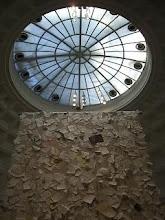::
Várias vezes tenho falado aqui sobre Nova Iorque. É, aliás, inevitável falar sobre esta cidade carismática, acompanhar as suas transformações, seguir os seus caminhos, sorver a sua literatura, beber da sua música, vibrar com a sua cultura.
Várias vezes tenho falado aqui sobre Nova Iorque. É, aliás, inevitável falar sobre esta cidade carismática, acompanhar as suas transformações, seguir os seus caminhos, sorver a sua literatura, beber da sua música, vibrar com a sua cultura.

Desta vez, descobri um livro marcante sobre esta cidade. Na realidade, difícil será não encontrar vasta e abundante literatura sobre esta temática, mas a maioria, como é natural, leitura de cordel e folhetins para turista. “New York Calling: From Blackout to Bloomberg” é uma obra fascinante, editada, curiosamente, pelo filósofo marxista Marshall Berman e pelo poeta, jornalista e fotógrafo Brian Berger.
:::
 Trata-se de uma colecção de 28 crónicas escritas por diferentes personalidades ligadas de algum modo à cidade e com mais de 200 fotografias que retratam, da forma menos institucional, esta metrópole inconfundível. Pessoas como a conhecida fotógrafa Margaret Morton, o jornalista político Tom Robbins ou o crítico gastronómico e cultural Robert Sietsema, escrevem sobre a cidade e dão-nos a conhecer o lado mais íntimo, a faceta mais soturna ou o espírito mais desconcertante desta metrópole.
Trata-se de uma colecção de 28 crónicas escritas por diferentes personalidades ligadas de algum modo à cidade e com mais de 200 fotografias que retratam, da forma menos institucional, esta metrópole inconfundível. Pessoas como a conhecida fotógrafa Margaret Morton, o jornalista político Tom Robbins ou o crítico gastronómico e cultural Robert Sietsema, escrevem sobre a cidade e dão-nos a conhecer o lado mais íntimo, a faceta mais soturna ou o espírito mais desconcertante desta metrópole.
 Trata-se de uma colecção de 28 crónicas escritas por diferentes personalidades ligadas de algum modo à cidade e com mais de 200 fotografias que retratam, da forma menos institucional, esta metrópole inconfundível. Pessoas como a conhecida fotógrafa Margaret Morton, o jornalista político Tom Robbins ou o crítico gastronómico e cultural Robert Sietsema, escrevem sobre a cidade e dão-nos a conhecer o lado mais íntimo, a faceta mais soturna ou o espírito mais desconcertante desta metrópole.
Trata-se de uma colecção de 28 crónicas escritas por diferentes personalidades ligadas de algum modo à cidade e com mais de 200 fotografias que retratam, da forma menos institucional, esta metrópole inconfundível. Pessoas como a conhecida fotógrafa Margaret Morton, o jornalista político Tom Robbins ou o crítico gastronómico e cultural Robert Sietsema, escrevem sobre a cidade e dão-nos a conhecer o lado mais íntimo, a faceta mais soturna ou o espírito mais desconcertante desta metrópole.:
 :
: Através de uma viagem temporal, percorremos 30 anos e a leitura ajuda-nos a perceber a cidade como era, como foi e como é actualmente. Quem desejar conhecer a cidade por trás da cidade deve ler este livro. Segundo a apreciação do New York Times, estas crónicas abrem-nos para a dimensão do carácter, a extensão da mudança e o peso da personalidade desta cidade. "This is the backdrop for New York Calling . . . Through the lens of New York politics, music, art and counterculture, we hear several, often fascinating takes on essentially the same story: how the squalor, struggles, crime, drugs, and free expression of the 1970s and 1980s gave way to a cleaner and safer city in the subsequent two decades, but one in which commercial development has often trumped, protecting existing residents and preserving a rich past.
Através de uma viagem temporal, percorremos 30 anos e a leitura ajuda-nos a perceber a cidade como era, como foi e como é actualmente. Quem desejar conhecer a cidade por trás da cidade deve ler este livro. Segundo a apreciação do New York Times, estas crónicas abrem-nos para a dimensão do carácter, a extensão da mudança e o peso da personalidade desta cidade. "This is the backdrop for New York Calling . . . Through the lens of New York politics, music, art and counterculture, we hear several, often fascinating takes on essentially the same story: how the squalor, struggles, crime, drugs, and free expression of the 1970s and 1980s gave way to a cleaner and safer city in the subsequent two decades, but one in which commercial development has often trumped, protecting existing residents and preserving a rich past.
If not explicitly intended, the collection places a special emphasis on the Bronx, and the artistic movements spawned by the chaos of the 1970s. Particular attention is paid to graffiti art and the rise of hip-hop, which was ushered in by Grandmaster Flash's 1982 hit 'The Message'. Perhaps less revelatory - as writers often cover the subject today - are the numerous sections which pay homage to the bad-old East Village, where 'bodega' grocery stores sold dime bags of marijuana, and where - as one contributor remembers – 'no restaurants... stayed open past 6:00pm' . . . the essays, whether read discretely or as a complete work, offer a near-unforgettable impression of an era."

Deixo o descritivo na contracapa que antecipa o conteúdo fascinante: “Acclaimed historian Marshall Berman and journalist Brian Berger gather here a stellar group of writers and photographers who combine their energies to weave a rich tale of struggle, excitement, and wonder. John Strausbaugh explains how Uptown has taken over Downtown, as Tom Robbins examines the mayors and would-be mayors who have presided over the transformation. Margaret Morton chronicles the homeless, while Robert Atkins offers a personal view of the city’s gay culture and the devastating impact of aids. Anthony Haden-Guest and John Yau offer insiders’ views of the New York art world, while Brandon Stosuy and Allen Lowe recount their discoveries of the local rock and jazz scenes. Armond White and Leonard Greene approach African-American culture and civil rights from perspectives often marginalized in so-called polite conversation.
::

:
Daily life in New York has its dramatic moments too. Luc Sante gives us glimpses of a city perpetually on the grift, Jean Thilmany and Philip Dray share secrets of Gotham’s ethnic enclaves, Richard Meltzer walks, Jim Knipfel rides the subways, and Robert Sietsema criss-crosses the city, indefatigably tasting everything from giant Nigerian tree snails to Fujianese turtles”

Curiosa é sobretudo a personagem de Marshall Berman. Comunista, intelectual, filósofo, professor de Ciência Política, controverso, insatisfeito. Um apreciador de Marx que se deixou encantar pela mística liberal e multicultural de New York.
 Berman é professor da “City University of New York”, conhecida humoristicamente como a “Harvard dos pobres”, pela mistura de brilhantismo académico e origem humilde de muitos de seus alunos e professores, classificação na qual se enquadra bem. Alguém escreveu que “Harold Bloom é considerado um dos maiores críticos literários em actividade. A premissa básica de Blomm é de que o mundo pode ser explicado pela obra Shakespeareana. Pois bem, os marxistas também têm seu Harold Bloom. Trata-se de Marshall Berman. Assim como Blomm só vê sentido nas obras quando tomada a partir do prisma shakespereano, Berman só entende o mundo partir de Marx. Assim como o “Cânone Ocidental” é uma obra de louvor a Shakespeare, “Tudo o que é sólido se desmancha no ar” é uma obra de louvor a Marx. Não há Bloom sem Shakespeare. Não há Berman sem Marx”.
Berman é professor da “City University of New York”, conhecida humoristicamente como a “Harvard dos pobres”, pela mistura de brilhantismo académico e origem humilde de muitos de seus alunos e professores, classificação na qual se enquadra bem. Alguém escreveu que “Harold Bloom é considerado um dos maiores críticos literários em actividade. A premissa básica de Blomm é de que o mundo pode ser explicado pela obra Shakespeareana. Pois bem, os marxistas também têm seu Harold Bloom. Trata-se de Marshall Berman. Assim como Blomm só vê sentido nas obras quando tomada a partir do prisma shakespereano, Berman só entende o mundo partir de Marx. Assim como o “Cânone Ocidental” é uma obra de louvor a Shakespeare, “Tudo o que é sólido se desmancha no ar” é uma obra de louvor a Marx. Não há Bloom sem Shakespeare. Não há Berman sem Marx”.:
Eu diria numa perspectiva mais terrena - não há pessoas perfeitas.












































































Sem comentários:
Enviar um comentário